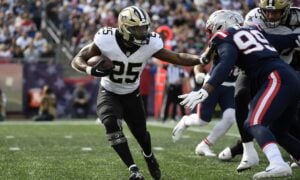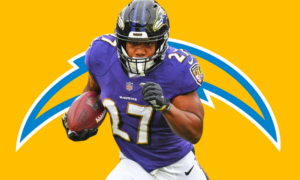The IDP Impact of Gregg Williams to the New York Jets
Think of the meanest son-of-a-gun coach you ever had when you played sports as a kid. Maybe it was your gym teacher, your Little League coach, or – heck – your own parent, but that coach would get in your face, scream at you, break you down into little pieces like a bad LEGO set. I don’t agree with the initial methods, but often it was in an attempt to build you back up, motivate you, and improve your game.
Now, take that caricature, give them glasses, a goatee, and a nylon tracksuit, and you have newly-hired New York Jets defensive coordinator Gregg Williams.
It’s hard to tell whether Williams has been more memeable for the blue streak that erupts out of his mouth on the sidelines or for asking his run-defending strong safety to play 25 to 30 yards deep regularly. Either way, Williams will take over the defense in a region whose own reputation for trash talk and quick tempers can perhaps hold a candle to Williams’ aggressing coaching style.
But how will Williams’ presence alter the Jets’ defense, and can the Individual Defensive Players (IDP) he’s coaching rise to the challenge?
Scheme
[am4show have=’g1;’ guest_error=’sub_message’ user_error=’sub_message’ ]
The Jets’ defensive coordinator switch is among the four this off-season where the team is overhauling its base scheme entirely, but the arrival of “Triple-G” Williams in Gotham might actually go more similarly than you think.
Williams has tended to oversee 4-3 defenses (four linemen, three linebackers), a changeup to former head coach Todd Bowles’s 3-4 front (three linemen, four linebackers). Williams is known for running aggressive, attacking schemes that seek to pressure the quarterback while the defensive backfield employs man-to-man coverage. Bowles’s units operate similarly, running a top-five rate of blitz plays on passing downs, regardless of the situation. As you check out that Pro Football Focus article, you’ll notice that the top team in blitz rate on second and third downs was the Cleveland Browns – Gregg Williams’s Browns, that is.
Obviously, each coordinator has their own play calling idiosyncrasies (which we’ll explore more in the next section), but – outside of the base defensive alignment – this defense should remain largely the same as it was under the previous regime. Let’s look at how that alignment will change, and what that means for the positional designations of its IDP options.
Below is a projected sketch of the Jets’ 2019 base 4-3 defense.

In a 4-3 front, we should see former Indianapolis Colts defensive end Tarell Basham return to his drafted position (and the starting lineup) as the only true 4-3 style end on the roster. This is a roster that will need edge rushers who truly fit the change in defensive scheme to be added to it in the near future, but Basham is the best option for right now.
It’s a toss-up between which of Leonard Williams or Henry Anderson will remain a defensive end (and retain the coveted DE tag in IDP leagues) or move to defensive tackle, but simply based on their PFF pass-rushing grades over the last few years – and the fact that Williams has played a higher rate of DE snaps – I’m assuming that Williams remains an end and will rush the passer more frequently, while Anderson slides back into the interior and will become more valuable in a DT-specific league.
In the second level, there’s little shakeup or surprise from the linebacking corps’ projection. Avery Williamson will remain the heavy tackler of the group and should continue to provide higher value in tackle-heavy IDP scoring systems because of his middle linebacker spot. Darron Lee will slide over to the WILL – or weak-side – linebacker spot, and his duties as the coverage off-ball linebacker will remain consistent as well.
Even though Williams ran a nickel (five defensive backs) or dime (six defensive backs) look at one of the lowest rates over the last few years, with the progress of the NFL towards more and more passing, we should know what the Jets will do to combat the three-plus wide receiver sets opponents throw at them. Here’s my expectation for the Jets’ nickel 4-2 defense.

In the nickel, the Jets will likely pull run-stuffing nose tackle Steve McLendon off the field, sliding Leonard Williams back into an interior role and dropping SAM – or strong-side – linebacker Jordan Jenkins down into a defensive end alignment. This alignment will allow them to get their four best pass-rushers onto the defensive line, while keeping a solid coverage duo of Williamson and Lee in the second level. Expect Lee to assume more varied coverage responsibilities, while Williamson will provide blitzes, short zones, and spy assignments.
As for the defensive backfield, not much will change in either the base or nickel. The only thing that could happen more is strong safety Jamal Adams getting to play closer to the box as a third linebacker/slot option, while free safety Darryl Roberts plays the deep “angel” safety role. That should keep Adams’s IDP value high, and Roberts will remain an inconsistent asset for fantasy purposes.
Usage and Production
New player alignments are perhaps the most noticeable change when a new defensive scheme is implemented, but it might not actually be the most impactful. This is why we have to carefully assess the play responsibilities and snap percentage that players and position groups are being given by defensive coordinators.
Using 2018 snap assignment data from Pro Football Focus, I looked at teams’ situational snap breakdown by position group to get an idea of how each defense was used (i.e. what percentage of snaps they rushed the passer, were in run defense, or in coverage).
There is some bias in this data based on the team’s success – for instance, a team often had a much higher run defense rate if they lost frequently, due to their opponents grinding down the clock through the run game – but when comparing each team’s position groups to the league average at each position, we see some interesting trends emerge.
For Gregg Williams’s Browns, there are quite a few notable elements.
First and foremost, Williams’s safeties (contrary to popular meme-ology) actually sit back in coverage at the sixth-lowest rate in the league, instead rushing the passer at the third-highest rate and playing run defense just outside the top-ten. In fact, these are nearly identical rates to the departing Todd Bowles’s safety units, so this is a strong indication that negative regression for Jamal Adams is not nigh; Williams will continue to use him near the line, allowing him to remain a fantasy point vacuum.
In addition, linebackers for Gregg Williams’s Browns were fourth-highest in pass-rush rate – a stark difference from the bottom-eight 2018 Jets. When we dig into that a little deeper, we can see that each of MIKE Joe Schobert, SAM Jamie Collins, and WILL Christian Kirksey all blitzed on 11 percent of their snaps or more, and Schobert and Collins were both blitzing about once every eight snaps. This means that Avery Williamson and Darron Lee will have plenty of chances to attack the backfield as well, a big boon for their fantasy futures. Jordan Jenkins has some sleeper value in deeper leagues here as well, due to usage patterns.
The one odd thing to note is the ninth-lowest pass-rush rate for interior defensive line players (DT’s in a 4-3, NT’s and most DE’s in a 3-4), and their top-three coverage rate at this position group. That’s not to say that Williams will be sending his big men to cover a running back on every play, but it’s worth noting that Henry Anderson and Steve McLendon could have a marginal disadvantage to other players at an already-devalued position for IDP fantasy football.
Wrap-Up
Williams loves to throw his defenders into the fray with blitzes, risky coverages, and aggressive defensive football, and that is generally a good thing as we look to evaluate the Jets’ defense going forward. As long as you keep your nose clean, your bounties gated, and your eyes on the ball – err, data – the Williams defense should offer some fun surprises for IDP fantasy players in the Meadowlands.
[/am4show]
- The IDP Impact of Steve Wilks to the Cleveland Browns - March 2, 2019
- The IDP Impact of Gregg Williams to the New York Jets - February 8, 2019
- The IDP Impact of Vic Fangio to the Denver Broncos - January 29, 2019

































































